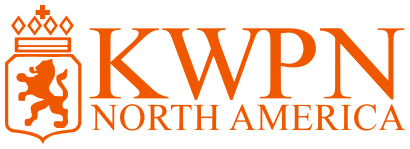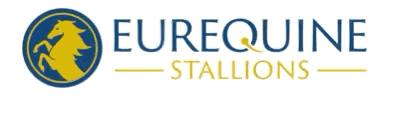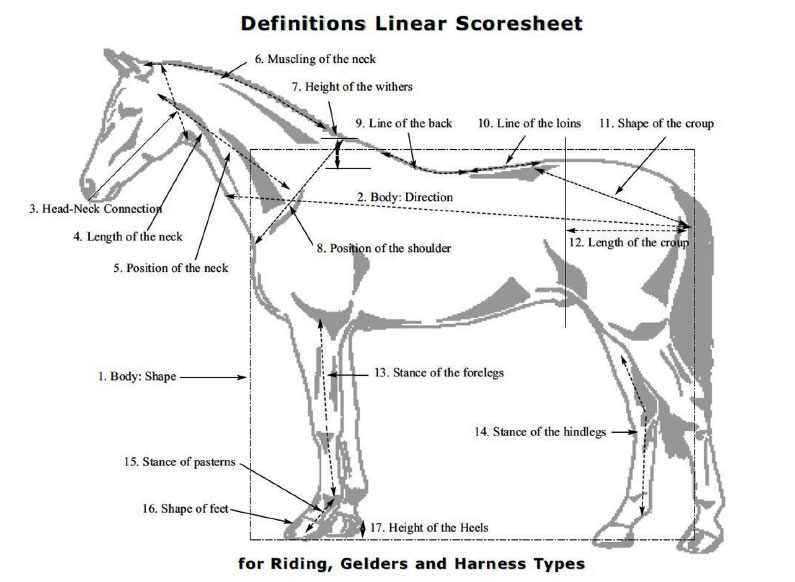Keurings
Linear Scoring
General Information
The linear score sheet consists of an upper and a lower beam. The lower beam contains conformation, movement and jumping components divided into 28 characteristics for dressage horses, 36 for jumpers and 24 for harness horses. By filling in circles ‘a’ through ‘i’ the jury passes on information to owners as to whether a certain characteristic is average (e–f range) or leans more toward one extreme or the other.
The upper beam gives an evaluation for conformation and movement of the horse on a scale from 40 to 100 points in 5 point increments. The upper beam for movement consists of the upper beam scores for walk, trot, canter and self-carriage for dressage; canter, reflexes, technique and scope for jumping; and movement and overall impression for harness.
Upper Beam Conformation
(all types)

Jabablahoma P (Nabab de Reve x Guidam) elite; Photo by Prima Equestrian
- Body: shape (rectangular–square) A horse is rectangular when the length (from point of the shoulder to the point of the buttock) is greater than the height. Horses need rectangular conformation in order to be athletic and elastic. A horse is square when the length of the horse is equal to the height of the withers.
- Body: direction (uphill–downhill) The direction of the body as compared to the horizontal. A horse is harder to collect when built on the forehand (downhill).
- Head-neck connection (light–heavy) This trait is actually divided in two; the length of the poll and the throatlatch. Light: a long poll, light throatlatch and small distance between the top and bottom of the neck. Heavy: a short poll, a heavy throatlatch and a larger distance between the top and bottom of the neck. A lighter connection is desirable for acceptance of the bit.
- Length of neck (long–short) The distance from the poll to the peak of the withers (relative to the rest of the topline).
- Position of neck (vertical–horizontal) The angle that the neck makes with the horizontal when the horse stands naturally. Dressage horses need a more vertical position of the neck for easy self-carriage and uphill balance. Jumpers need a more horizontal position of the neck in order to collect themselves just before and during take-off.
- Muscling of neck (heavy–poor) The measure of muscling in the neck, especially in the topline. Heavy: slight cresting of a thick neck. A rounded topline is a matter of muscling. Poor: thin neck, often with weak connection of topline into the withers.
- Height of withers (high–flat) The height of the wither measured as the distance between two horizontal lines – one through peak of the withers, the other through the base of the withers. The height of the wither is important for a good saddle placement.
- Position of the shoulder (sloping–straight) The angle of the shoulder with the horizontal.
- Line of the back (roached–weak) The course of the topline between the withers and the loins. A smooth, well-muscled topline enables the horse to move with good use of the back.
- Line of the loins (roached–weak) The course of the topline from the back to the croup. Strong muscling is needed to stretch the back and hindquarters during the second phase of the jump.
- Shape of croup (sloping–flat) The angle from the point of the hip to the point of the buttock. Too much slope hinders flexibility of the pelvis, which is needed for collection, especially in piaffe and passage.
- Length of croup (long–short) The length from the point of the hip to the point of the buttock. The length is important for proportional conformation: the forehand, middle and hindquarters should form equal sections.
- Stance of forelegs (over at the knee–back at the knee) The angle made by lines drawn through the forearm and cannon, as seen from the side. The stance of the forelegs should be straight to insure durability.
- Stance of hindlegs (sickle hocked–straight) The angle made by lines drawn through the gaskin and cannon, as seen from the side. The hock angle should be approximately 150 degrees.
- Stance of pasterns (weak–upright) The angle made by the pasterns of the forelegs with the ground. A pastern that is too short and/or upright is more susceptible to concussive injury; a pastern that is long and too sloped (‘soft’ or ‘weak’) is more easily strained.
- Shape of feet (wide–narrow) The relation between the coronet band and the carrying surface viewed from the front. Note: with unequal hooves, the narrow hoof is considered to be abnormal. The horse’s feet should be large and symmetrical.
- Heels (high–low) The height of the heels of the front hooves, measured between the ground and the coronet band. The heels are responsible for a correct position of foot and pastern. Heels that are broad and moderately high are best for soundness.
- Quality of legs (lean–blurred) The extent to which the hindlegs are free from blemish or swelling. Lean legs show soundness and general quality.
- Substance of legs (heavy–fine) The circumference of the leg, including the size of the joints, relative to the size of the horse’s body. A horse needs well-developed bones, joints and tendons in order to be durable. (This trait is not scored in harness horses.)
Upper Beam – Conformation
A total score for the horse’s conformation.
Upper Beam Movement
(for dressage, jumping, hunter and Gelders breeding direction)
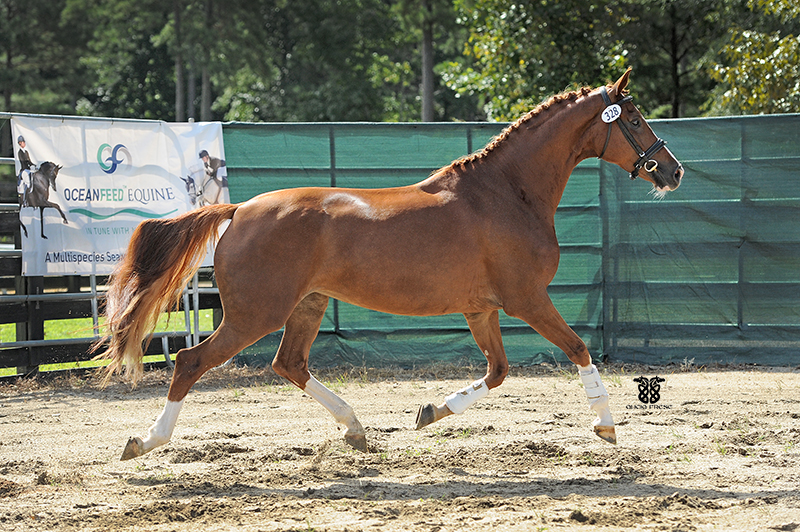
Hibiscus N.D. (Charmeur x Havidof); Photo by Alicia Frese Photography
- Walk: length of stride (long–short) The length of the stride.
- Walk: correctness (toed in–toed out) The walk evaluated from the front. When the hooves turn in from the fetlock, they are considered to be toed-in. When the hooves turn out from the fetlock, they are toed-out.
- Trot: length of stride (long–short) The length of the stride.
- Trot: suppleness (elastic–stiff) The measure of elasticity with which the movement flows through the body and is then absorbed by the legs.
- Trot: impulsion (powerful–weak) The measure in which the horse pushes off the ground with the hindlegs.
- Trot: balance (carrying–pushing) The combination of body position and the measure in which the hindleg carries.
- Canter: length of stride (long–short) The length of the stride.
- Canter: impulsion (powerful–weak) The measure in which the horse pushes off the ground with the hindlegs.
- Canter: balance (carrying–pushing) The combination of body position and the measure in which the hind leg carries.
Upper Beam – Movement
Dressage: movement consists of separate evaluations of the walk, trot, canter and self-carriage of the horse. The overall evaluation consists of the average of the walk, trot, canter and self-carriage.
Jumper and Hunter: horses will receive a score for walk and trot but they do not count in the overall score.
Upper Beam Movement
(for harness breeding direction)
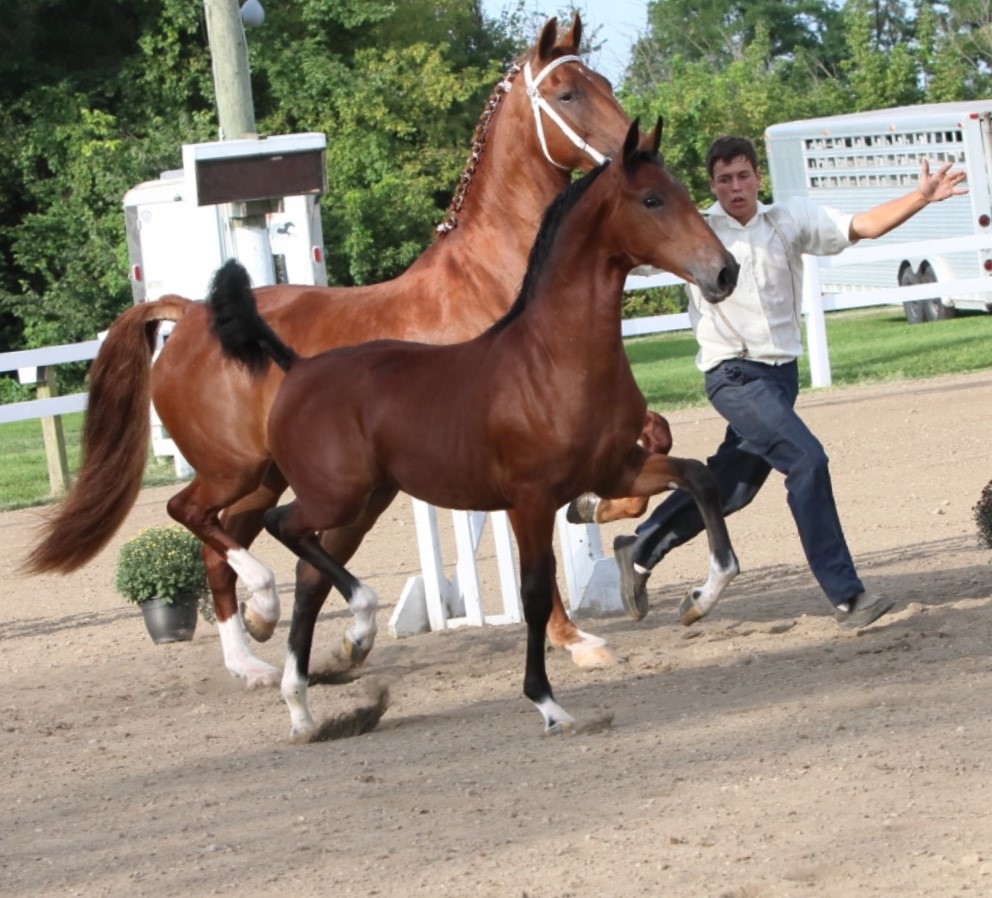
Neva (Hermanus x Emy-Duca Ster by Reflex M)
- Walk: length of stride (long–short) The length of the stride.
- Walk: correctness (toed in–toed out) The walk is evaluated from the front. When the hooves turn in from the fetlock they are considered to be toed-in. When the hooves turn out from the fetlock they are toed-out.
- Trot: self-carriage (much–little) The combination of body position and the measure in which the hindleg carries.
- Trot: suspension (long–short) The duration the horse is suspended above the ground with each powerful stride.
- Trot: action of the forelegs (high–low) The measure in which the horse lifts the forearm to the horizontal.
- Trot: use of hindleg (powerful–weak) The measure in which the horse pushes off with the hindlegs.
Upper Beam – Movement
Harness: an overall evaluation of movement.
Jumping Characteristics
(for jumping, hunter and Gelders breeding directions)

Lady Ada Bloom ster k/elig (Corland keur x Feather Bloom by Mr. Blue keur)
- Take off: direction (upwards–forwards) The measure in which the horse is able to elevate the withers.
- Take off: quickness (quick–slow) In the last canter stride before the jump—the time between when the forelegs and the hindlegs hit the ground and the moment when the horse leaves the ground.
- Technique: foreleg (bent–stretched) The measure in which the shoulder bends, in combination with the upper arm, forearm and the cannon; ‘tuck.’
- Technique: back (rounded–hollow) The measure in which the neck and back follow the arc over the jump; ‘bascule.’
- Technique: haunches (open–fixed) The measure in which the angles of the haunches are able to open during the second phase of the jump.
- Scope: (much–little) The ability of the horse to jump upward with power while at the same time developing a forward direction.
- Elasticity: (supple–stiff) The measure of fluidity in which the entire jump (including the landing) flows because of elasticity in the body.
- Care: (careful–not careful) The natural ability of the horse to jump without mistakes; the horse’s desire not to knock down a rail.

